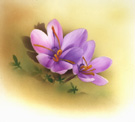| Latin Name | Crocus sativus Linn. (Iridaceae) |
| English Name | Saffron |
| Sanskrit Names | Kumkuma, Kashmira |
| Hindi Names | Kesar, Zafran |
 Distribution: The plant is a native of south Europe and is cultivated in Spain, France, Italy, Greece, Turkey, Persia, India and China. Cultivation in India is mostly confined to the table-land of Pampur (5,300 ft. above sea level) in Kashmir and Kishtwar in Jammu. Habit: The saffron plant is a small bulbous perennial, cultivated for its large, scented, blue or lavender flowers. The flowers have a trifid, orange-coloured stigma which along with the style-tops yield the saffron of commerce. Principle constituents: The glycosides, crocin and picrocrocin together with lycopene, ß-carotene, g-carotene, zeaxanthin and a crystalline hydrocarbon. Indications: Saffron is credited with various medicinal properties. It is used as a nerve sedative and emmenagogue. It is used in fevers, melancholia and enlargement of the liver. It also has stimulant and stomachic properties and is considered to be a remedy for catarrhal affections of children. Product range: Abana, Geriforte, Tentex forte |
|